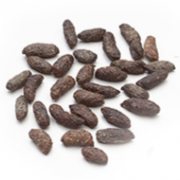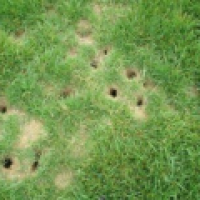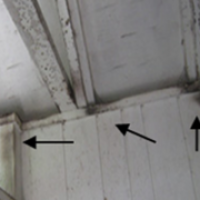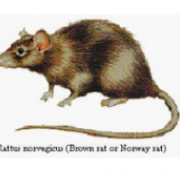Rats
Rats
Please click here to download our informational Rat Brochure.
How Do I Know if Rats are on my Property?
The presence of rats can be determined by a number of signs described below. Droppings may be found along runways, in feeding areas, and near shelter. They may be as large as 3/4 inch (2 cm) long and 1/4 inch (0.6 cm) in diameter. Fresh droppings are soft in texture.

Tracks, including footprints or tail marks, may be seen on dusty surfaces or in mud. A tracking patch made of flour can be placed in pathways overnight to determine if rodents are present.
Urine, both wet and dry, will fluoresce under ultraviolet light. Urine stains may occur along travelways or in feeding areas.
Runs or burrows may be found next to walls, along fences, next to buildings, or under bushes and debris. Rats memorize pathways and use the same routes habitually.

Smudge marks (rub marks) may occur on beams, rafters, pipes, and walls as a result of oil and dirt rubbing off rats’ fur along frequently traveled routes.

Gnawing may be visible on doors, ledges, in corners, in wall material, on stored materials, or other surfaces wherever rats are present. Fresh accumulations of wood shavings, insulation, and other gnawed material indicate active infestations. Size of entry holes (often 1 1/2 inches [4 cm] in diameter or less for mice, 2 inches [5 cm] or larger for rats) or tooth marks can be used to distinguish rat from mouse gnawing. Rats keep their paired incisor teeth, which grow continuously at the rate of about 5 inches (13 cm) per year, worn down by gnawing on hard surfaces and by working them against each other.
Sounds such as gnawing, climbing in walls, clawing, various squeaks, and fighting noises are common where rats are present, particularly at times of the day when they are most active.
What Can I Do to Prevent Rats?
Rat-Proof Your House!
If you can successfully guard your house from rodents, you’ll never have to worry about an infestation as long as you keep up with maintenance. Whether you’ve just entered a new home or heard of a nearby infestation, it’s important to take the time and complete the following steps toward rat-proofing your home.
Start by inspecting the foundation of your home. Look for gaps or holes that may be large enough for a rat to enter. You can block off those entry points with expandable foam or mesh.
Once those areas are secured, check your doors and windows. This is especially important at the change of seasons, when doors and windows may warp and leave gaps large enough for rodents can crawl into. Metal kickplates are a good solution for these, as well as insulation treatment.
Next, inspect your roof. If your vents, shingles, or chimneys allow access to your attic, you may have a problem: roof rats can be especially difficult to eradicate once they’ve gotten in there. Cap the chimney when it is not being used, fix any holes that might be in your vents, and make sure your roof is in good repair in general.
In the same vein as inspecting your roof, you’ll want to inspect your basement if you have one. If there are any holes or cracks around your plumbing, these can be easy and covert areas for rats to get into your home. Make sure these small openings are all sealed up and that you also have proper sealant on your basement door.
Consider using a metal rodent guard if you have any wire lines or pipelines that come from the outside into the house. You can also block holes with a mixture of steel wool and mortar or caulk.
Eliminate Food Sources!
If storing trash and food waste inside the home, do so in rodent-proof containers, and frequently clean the containers with soap and water. Dispose of trash and garbage on a frequent and regular basis, and pick up or eliminate clutter.
Eliminate possible nesting sites outside the home. Elevate hay, woodpiles, and garbage cans at least 1 foot off the ground. Move woodpiles far away from the house (100 feet or more is best). Get rid of old trucks, cars, and old tires that mice and rats could use as homes. Keep grass cut short and shrubbery within 100 feet of the home well trimmed.
- Keep food in thick plastic or metal containers with tight lids.
- Clean up spilled food right away and wash dishes and cooking utensils soon after use.
- Keep outside cooking areas and grills clean.
- Always put pet food away after use and do not leave pet-food or water bowls out overnight.
- Keep bird feeders away from the house and utilize squirrel guards to limit access to the feeder by squirrels and other rodents.
- Use a thick plastic or metal garbage can with a tight lid.
- Keep grains and animal feed in thick plastic or metal containers with tight lids. In the evening, uneaten animal feed should be returned to containers with lids.
- Keep compost bins as far away from the house as possible (100 feet or more is best).
WHEN IN DOUBT, ALWAYS CONTACT A LICENSED EXTERMINATOR!!
Why are Rats a Problem?
Some consider Norway rats , also known as Sewer rats or Brown rats, to be the greatest mammal pest of all time. They have caused more deaths than all the wars in history. Rat-borne diseases are thought to have killed more people in the last 1,000 years than all of the wars and revolutions ever fought. They harbor lice and fleas that carry bubonic plague, typhus, trichinosus, tularemia, infectious jaundice, and many other serious diseases. Rats also cause considerable damage to property including crops, destroying and pollution of human food storage, and damage to insides and outsides of buildings. It is estimated that rats cause almost 1 billion dollars in damage in the United States each year. Rats kill poultry, domestic livestock, and game birds, and are responsible for the endangerment or extinction of many species of wildlife, especially those found on islands.

Rat Facts
- Rats take care of injured and sick rats in their group.
- Without companionship rats tend to become lonely and depressed.
- Rats have excellent memories. Once they learn a navigation route, they won’t forget it.
- Rats make happy “laughter” sounds when they play.
- Rats succumb to peer-pressure, just like humans. Brown rats are prone to disregard personal experiences in order to copy the behavior of their peers. The urge to conform is so strong that they will even choose to eat unpalatable food if they are in the company of other rats who are eating it.
- A rat can go longer than a camel without having a drink of water.
- Rats’ tails help them to balance, communicate and regulate their body temperature.

